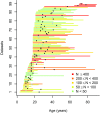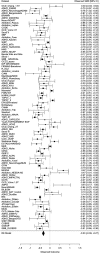Mapping cortical brain asymmetry in 17,141 healthy individuals worldwide via the ENIGMA Consortium
- PMID: 29764998
- PMCID: PMC5984496
- DOI: 10.1073/pnas.1718418115
Mapping cortical brain asymmetry in 17,141 healthy individuals worldwide via the ENIGMA Consortium
Abstract
Hemispheric asymmetry is a cardinal feature of human brain organization. Altered brain asymmetry has also been linked to some cognitive and neuropsychiatric disorders. Here, the ENIGMA (Enhancing NeuroImaging Genetics through Meta-Analysis) Consortium presents the largest-ever analysis of cerebral cortical asymmetry and its variability across individuals. Cortical thickness and surface area were assessed in MRI scans of 17,141 healthy individuals from 99 datasets worldwide. Results revealed widespread asymmetries at both hemispheric and regional levels, with a generally thicker cortex but smaller surface area in the left hemisphere relative to the right. Regionally, asymmetries of cortical thickness and/or surface area were found in the inferior frontal gyrus, transverse temporal gyrus, parahippocampal gyrus, and entorhinal cortex. These regions are involved in lateralized functions, including language and visuospatial processing. In addition to population-level asymmetries, variability in brain asymmetry was related to sex, age, and intracranial volume. Interestingly, we did not find significant associations between asymmetries and handedness. Finally, with two independent pedigree datasets (n = 1,443 and 1,113, respectively), we found several asymmetries showing significant, replicable heritability. The structural asymmetries identified and their variabilities and heritability provide a reference resource for future studies on the genetic basis of brain asymmetry and altered laterality in cognitive, neurological, and psychiatric disorders.
Keywords: brain asymmetry; cortical thickness; lateralization; meta-analysis; surface area.
Conflict of interest statement
Conflict of interest statement: B.F. received educational speaking fees from Merz and Shire. Some ENIGMA members listed in SI Appendix also declare a conflict of interest. The other authors declare no conflict of interest.
Figures






References
-
- Vigneau M, et al. Meta-analyzing left hemisphere language areas: Phonology, semantics, and sentence processing. Neuroimage. 2006;30:1414–1432. - PubMed
-
- Willems RM, Peelen MV, Hagoort P. Cerebral lateralization of face-selective and body-selective visual areas depends on handedness. Cereb Cortex. 2010;20:1719–1725. - PubMed
-
- Zhen Z, et al. Quantifying interindividual variability and asymmetry of face-selective regions: A probabilistic functional atlas. Neuroimage. 2015;113:13–25. - PubMed
-
- Zago L, et al. Pseudoneglect in line bisection judgement is associated with a modulation of right hemispheric spatial attention dominance in right-handers. Neuropsychologia. 2017;94:75–83. - PubMed
Publication types
MeSH terms
Grants and funding
- P20 DA022539/DA/NIDA NIH HHS/United States
- 500236/Z/11/Z/WT_/Wellcome Trust/United Kingdom
- R01 EB006841/EB/NIBIB NIH HHS/United States
- R00 MH091238/MH/NIMH NIH HHS/United States
- R01 MH094524/MH/NIMH NIH HHS/United States
- U54 EB020403/EB/NIBIB NIH HHS/United States
- R01 EB000840/EB/NIBIB NIH HHS/United States
- R01 DA018307/DA/NIDA NIH HHS/United States
- MC_UU_00011/5/MRC_/Medical Research Council/United Kingdom
- K08 MH068540/MH/NIMH NIH HHS/United States
- R01 AA013892/AA/NIAAA NIH HHS/United States
- PL1 DA024859/DA/NIDA NIH HHS/United States
- R01 MH115357/MH/NIMH NIH HHS/United States
- R01 MH086654/MH/NIMH NIH HHS/United States
- MR/K026992/1/MRC_/Medical Research Council/United Kingdom
- R01 MH117107/MH/NIMH NIH HHS/United States
- HHSN271200800009C/DA/NIDA NIH HHS/United States
- R01 EB005846/EB/NIBIB NIH HHS/United States
- T32 DA022975/DA/NIDA NIH HHS/United States
- R01 DA020726/DA/NIDA NIH HHS/United States
- P20 RR021938/RR/NCRR NIH HHS/United States
- R56 MH086654/MH/NIMH NIH HHS/United States
- R01 MH096773/MH/NIMH NIH HHS/United States
- R01 MH085734/MH/NIMH NIH HHS/United States
- RC1 MH089257/MH/NIMH NIH HHS/United States
- U24 RR021992/RR/NCRR NIH HHS/United States
- K99 AA025401/AA/NIAAA NIH HHS/United States
- BB_/Biotechnology and Biological Sciences Research Council/United Kingdom
- R01 DA015179/DA/NIDA NIH HHS/United States
- G0500092 /MRC_/Medical Research Council/United Kingdom
- UL1 TR000128/TR/NCATS NIH HHS/United States
- R01 DA014100/DA/NIDA NIH HHS/United States
- G1001245/MRC_/Medical Research Council/United Kingdom
- P50 DA016556/DA/NIDA NIH HHS/United States
- UL1 DE019586/DE/NIDCR NIH HHS/United States
- P20 GM103472/GM/NIGMS NIH HHS/United States
- G0701120/MRC_/Medical Research Council/United Kingdom
- R01 MH099064/MH/NIMH NIH HHS/United States
LinkOut - more resources
Full Text Sources
Other Literature Sources
Miscellaneous

